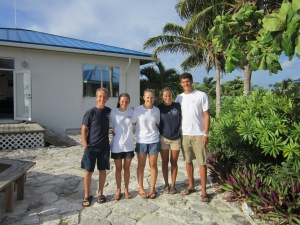In a recent Marine Ecology class, students were asked to stay still, underwater, on SCUBA, for half an hour, focusing their observations on one specific area of reef. They then wrote underwater essays on their dive slates, addressing the prompt: Why (or why not) is there so much life on this area of reef. Enjoy these examples: deeply thoughtful analyses written deep under water…
by Chapin Atwood:
I arrived at my patch of coral reef and sank to my knees as I began to watch all the components of this ecosystem react. Watching the fish, busily flipping their tales around pieces of coral reef and sponges, I was amazed at the beauty of this small piece of reef. This reef looked very healthy with life bursting out of it.
After a few moments of enjoying its beauty, I began to study the components of the coral reef in depth. I began by looking at the biotic factors of the reef, such as the different types of sponges and algae and fish species. I noticed large patches of Encrusting sponges as well as the Rope sponges and Tube sponges. All of these species of sponges have a similar niche in the ecosystem, to filter the water and take out nutrients and oxygen from the water. They get their food by filtering the water, which means that they are heterotrophs because they amass organic matter from other sources. I noticed the small holes on each of these sponges, placed in different places for the different species. These holes were the oscula, in which the filtered water came out of. When looking closely at some of the Encrusting sponges, I noticed this layer of green algae that covered the sponge. I wondered what its name was? I also wondered if it has a severe effect on the health of the coral reef? Continue reading



